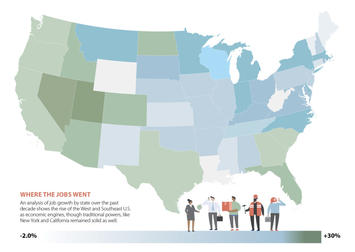
A decade ago, in the wake of the Great Recession, Lee County, Florida was dubbed “the foreclosure capital of the country” by the national media, the poster child for all that had gone wrong with the American economy.
“Homes are selling at 80 percent off their peak prices,” reported The New York Times in February, 2009. “Only two years after, there were more jobs than people to work them, fast-food restaurants are laying people off or closing. Crime is up, school enrollment is down, and one in four residents received food stamps in December, nearly a fourfold increase since 2006.
“Welcome,” boomed The Times, “to the American dream in reverse.”
What a difference a decade makes. Today, Florida—and Lee County—is thriving again, with thousands of businesses and hundreds of thousands of people flocking to the Sunshine State annually. It seems that—surprise!—warm weather and zero income tax are catnip for employers and workers alike.
But Florida is hardly alone. Job growth in the U.S. over the past decade has been about 13 percent but some states and some regions have been outperforming the nation by a large margin. So which states are hot, and which are not? And what does the future hold—especially in key sectors like technology and professional services?
To find out, we analyzed recent job growth data for all 50 states over ten-, five-, and one-year periods. For each time period we looked at overall growth, as well as the manufacturing, high-tech and professional and technical business services sectors.
What emerges is a picture, particularly for job creation, that is complex but consistent over the past 10 years—and likely will be for the decade ahead. All people may have been created equal—but states are not. Simply put, the big winners are all in the Sunbelt and the Intermountain West. And we project that trend will continue.
At the top of the heap—with growth rates over 20 percent—are, in order, Utah, Nevada, Florida, Texas and Colorado. Their growth has been more than the rate of growth of states like New York and others on the Atlantic seaboard, as well as most Midwestern states. Not surprisingly, these states all boast the highest population growth rates and are home to many of the nation’s fastest growing metros. Austin leads the pack, followed by Orlando. Denver, Dallas and Las Vegas can all be counted among the fastest growing metropolitan regions.
At the end of the list, sadly, there’s consistency as well. The bottom rungs are dominated by poor, resource-dependent states such as Louisiana, West Virginia and Wyoming—but also now include traditionally buoyant economies such as Connecticut, whose 3.3 percent growth over a decade is roughly one quarter of the national average. There’s nothing in the data we looked at that shows these trends will change, either.
Momentum Tilts to the Heartland and the Sunbelt
In our modern high-velocity economy, 10 years can seem like an epoch. Yet our top states generally have remained remarkably consistent in performance. The slowing growth in hyper-regulated California and the generally mediocre performance along the Northeast corridor has boosted the status of states like Texas, Florida, Arizona and Idaho, which are benefiting from mass migration of both companies and people.
Unlike its East Coast counterparts, the Golden State, however, has been a solid performer, though growth has slowed in the past year. It ranked a solid 9th over the past decade, with almost 18 percent growth. California’s strength can be attributed in part to its economic diversity, with strong concentrations in agriculture, information, professional services and entertainment.
It has started to fade, likely due to high housing prices, rising out-migration (Los Angeles lost population last year) and sky high taxes. Last year, the state ranked 13th and, given the fires and new regulatory burdens, one can expect that to drop further. The state’s manufacturing economy is withering, and after averaging about 100,000 new healthcare jobs annually in the nine years before 2018, just 20,000 were created in the last year.
We may be on the cusp of continued weakening for high-tax, highly regulated states—particularly those that lack California’s ideal weather (most of the time) and spectacular topography. New York ranked a respectable 19th over 10 years, but last year it dropped to 22nd. Massachusetts, 16th over the decade, fell to 27th last year. Other traditional leaders, like Illinois, which dropped from 17th worst over 10 years to 4th worst last year and especially Connecticut also are losing momentum, according to last year’s figures. All have dropped off their 10-year pace.
Where Tech Is Headed
Of course, not all jobs are the same. Some tend to pay more, and some occupations are expanding more rapidly as the economy changes. High-tech employment has grown in almost all our leading states, but the biggest winners over ten years have been varied: led by North Carolina, Utah, South Dakota, California and New York.
But here again last year’s numbers project something of a different cast. The biggest change was the emergence as the fastest-growing state in the past year: Idaho. Over 10 years, Idaho registers in the bottom third, but last year it enjoyed the fastest tech growth in the nation. Boise and its surrounding region are booming, with newcomers pouring in from the West, not only California. It is now the fastest-growing metro in the nation.
Click to read the rest of this piece at chiefexecutive.net.
Joel Kotkin is the presidential fellow in urban futures at Chapman University and executive director of the Center for Opportunity Urbanism. His most recent book is The Human City: Urbanism for the Rest of Us. Mark Schill is the Vice President of Research and a community and economic development planner at Praxis Strategy Group.












